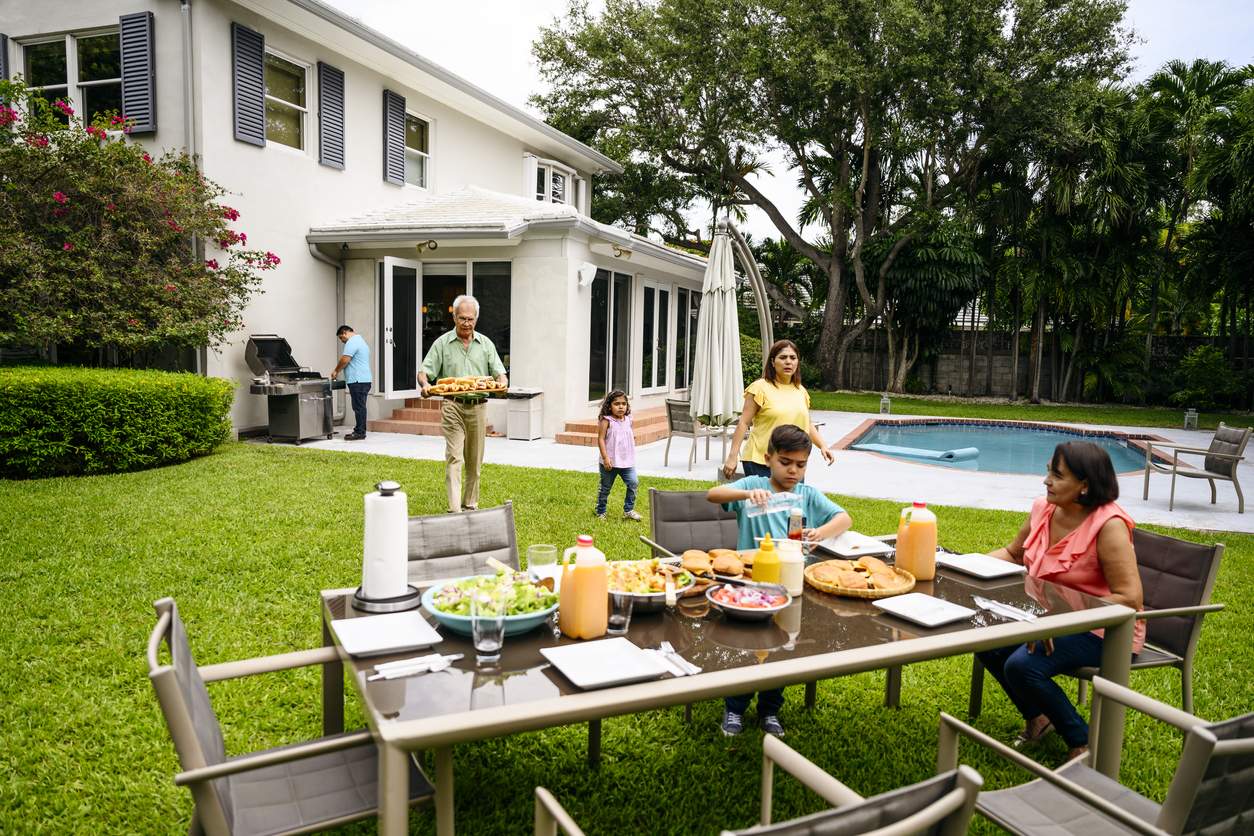Florida’s a diva.
Its beachy beauty comes with an attitude of harsh storms, high heat, and sandy soil. As a result, the state makes it difficult to build a front or backyard landscape that agrees with your taste and the state’s environmental conditions.
But with the right Florida landscaping ideas and guiding principles, you can create an attractive, enriching, and relaxing yard that’ll turn the heads of guests and pollinators alike.
Combining plants and hardscaping creates a desirable landscape for your home’s outdoor spaces.
A Note on Hardiness Zones
The growing conditions for plants differ depending on where you live in Florida. These areas are hardiness zones, which the US Department of Agriculture uses to divide the country’s regions based on their coldest winter temperatures.
Florida’s hardiness zones range from 8a in the north to 11a in the south. One of the best low-maintenance Florida landscaping ideas is to choose plants adapted to your zone’s weather and soil conditions, so they’ll be easier to keep alive and thrive.
What is Hardscaping?
Hardscaping involves using manufactured elements in a landscape, which may depend on your yard’s conditions. Think of hardscaping as your yard’s pathways, walls, decorations, and structures.
11 Florida Landscaping Ideas With Plants
You may desire purely aesthetic plants for your front and backyards, but be intentional about what you choose if you want them to last.
The following ideas will help you make smart decisions when choosing plants and deciding how to arrange them in your yard.
1. Use Native Plants
After determining which Florida hardiness zone you live in, aim to buy plants native to the state that prefer your zone’s climate. These plants naturally attract native wildlife and have more flexible water and fertilizer needs.
Search for native plants on a database like the Audubon Society’s.
2. Pick Leaves Over Flowers
Many flowers die throughout the seasons and require more care than other low-maintenance plants.
Choosing plants with appealing leaves or foliage rather than choosing based on flowers is a good practice to ensure a constantly pleasant yard. Perennial plants that have pretty leaves and enjoy lots of sunshine are great for Florida yards.
For example, variegated crotons are native and have striking multicolored leaves.
3. Choose Plants for Pollinators and Wildlife
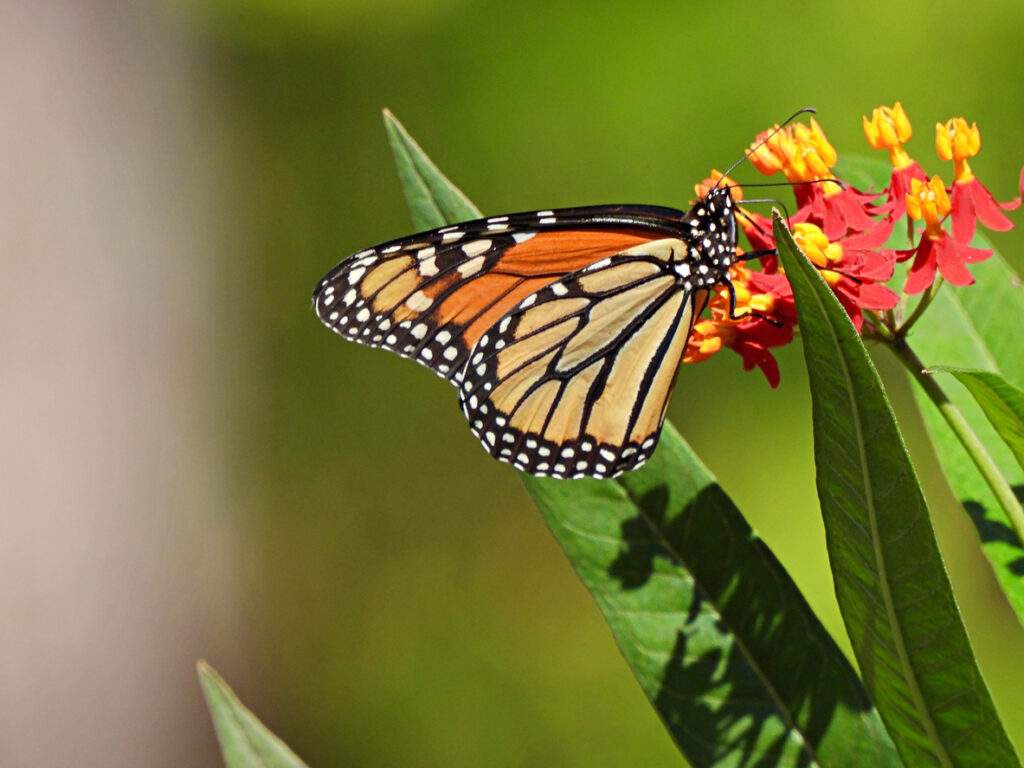
A good Florida home landscape idea is to choose plants that attract pollinators and other wildlife to create a balanced ecosystem.
Pollinators, like bees and butterflies, allow plants to reproduce and flower. Other animals, like dragonflies, eat pests that annoy you and damage plants.
4. Choose Plants That Suit the Space
You wouldn’t give your toddler the biggest bedroom, so don’t put your tiny, slow-growing plants in large areas of your yard. Aim to place fast-growing plants in larger areas, as they will quickly fill the space.
5. Create Denser Plant Spaces
When planting, space your plants only slightly apart so their leaves grow to overlap even before they reach maturity. The denser foliage cover these plants will create will help keep the soil moist and block sunlight for pesky weeds.
6. Group Plants with Similar Needs
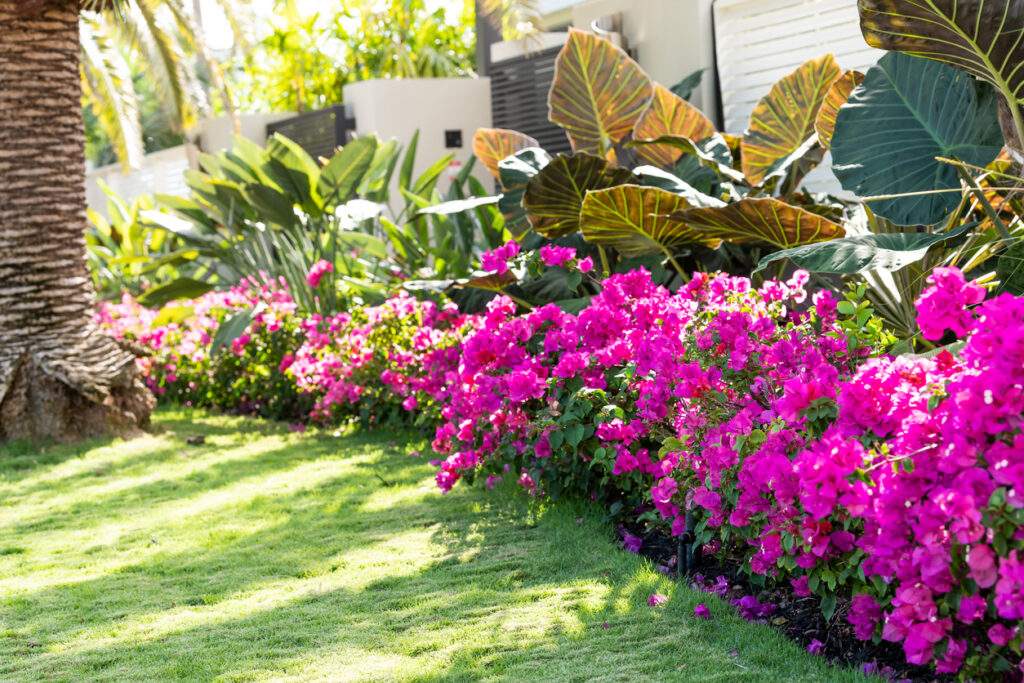
Coordinate the needs of different plants, such as those that need full sun, to use your space and resources efficiently.
Grouping plants with the same water needs ultimately conserves water and saves money. With this setup, you can use drip irrigation to water your plants.
Drip irrigation uses tubes to release water throughout the day directly into the soil surrounding your plants.
7. Relocate or Remove Unhealthy Plants
Especially for your Florida front yard landscaping, you’ll want to keep damaged or dying plants away from view.
If pests or diseases infect these plants, you’ll want to relocate and remedy them or remove them altogether to prevent the spread to adjacent plants.
8. Grow Plants With a Wider Spread
If you have the room and enjoy elegantly large plants, incorporate plants with a wider spread, like a large palm tree.
The larger the plants in your yards, the fewer plants you’ll have to maintain.
9. Use Trees or Large Shrubs for Shade
Besides being gorgeous points of interest, trees, large shrubs, and other large plants can provide shade for groundcover and smaller plants. You can also use these larger plants to shade AC units, windows, and seating areas.
Larger plants are also good for obstructing or transforming unattractive areas like blank walls, utilities, and bare spots in your lawn.
A Note on Planting Trees Near the House
Florida has strong winds during severe storms and hurricanes that can topple trees, and trees’ thick roots can damage flooring.
You’ll want to strategically plant large and medium trees at least 15 to 20 feet away from your home to avoid damage while still offering shade.
10. Add Evergreen Trees
Adding evergreen trees to your yard is a great landscaping idea in Florida because they maintain their foliage and color year-round. Choose a tall palm or pine tree that defines and adds stability to your yard.
Important Note on Planting Trees Near Your Home
Just make sure to plant evergreen trees far enough away from your home to avoid potential damage to roofs, windows, and other structures during a storm.
11. Add Plants That Are Appealing in Their Natural Form
Plants like bromeliads that don’t need pruning can reduce the need for maintenance while contributing natural beauty to your yard.
Contrast these naturally clean-cut plants with a freer natural form, like beautyberry, to create variety and visual interest.
10 Florida Hardscaping Ideas
Hardscaping in Florida can transform your yards into resort-like relaxation spaces.
Along with the above landscape ideas for Florida homes, hardscaping offers a sense of structure and spatial organization to an otherwise wild yard. With both types of landscaping, you can get in touch with nature while still feeling comfortable.
Most of the following are Florida backyard ideas because backyards offer a more secluded and flexible space to explore hardscaping. However, feel free to apply these ideas to your front yard as you see fit.
1. Organize Your Yard With Simple Geometric Shapes
Contrast your plants’ organic and untame forms with simple geometric shapes like circles or squares. You can use rectangular raised plant beds or encircle your trees with cut stones to cleanly highlight the natural beauty of your yard.
2. Create Shade
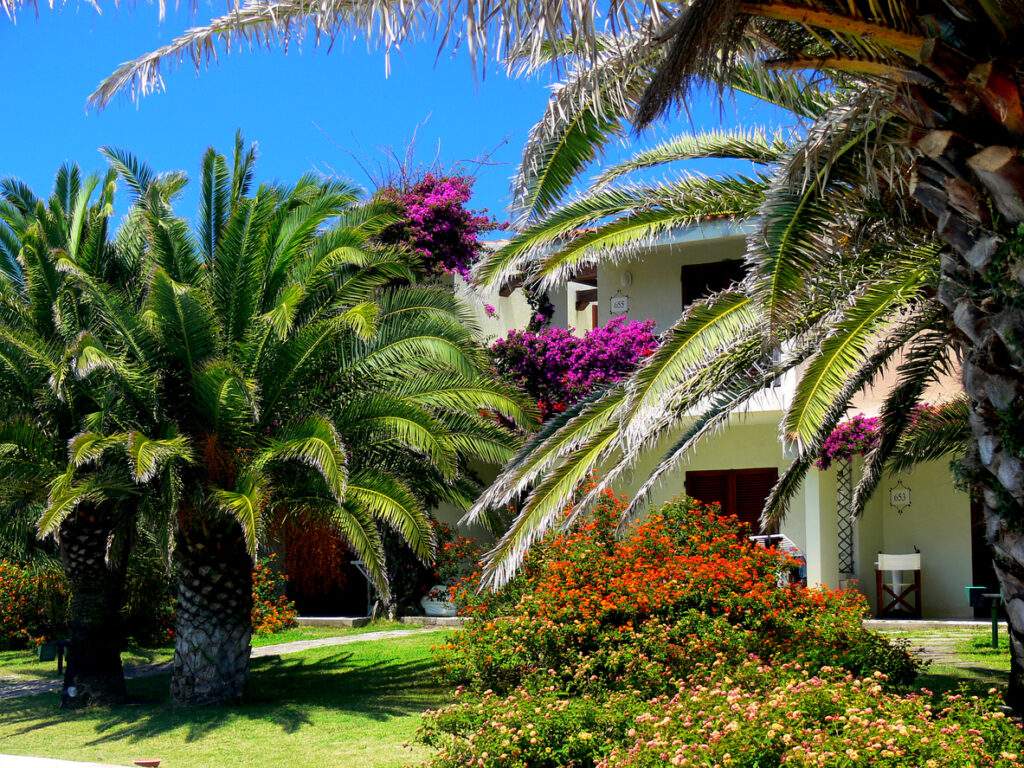
Florida, especially South Florida, landscaping should account for the intense heat you’ll experience almost daily.
Much like a large tree offers natural shade, structures like pergolas or awnings can add even more shade that protect wooden decor and furniture from sun and water damage.
These architectural additions also provide privacy and style to your yard.
3. Install Water Features
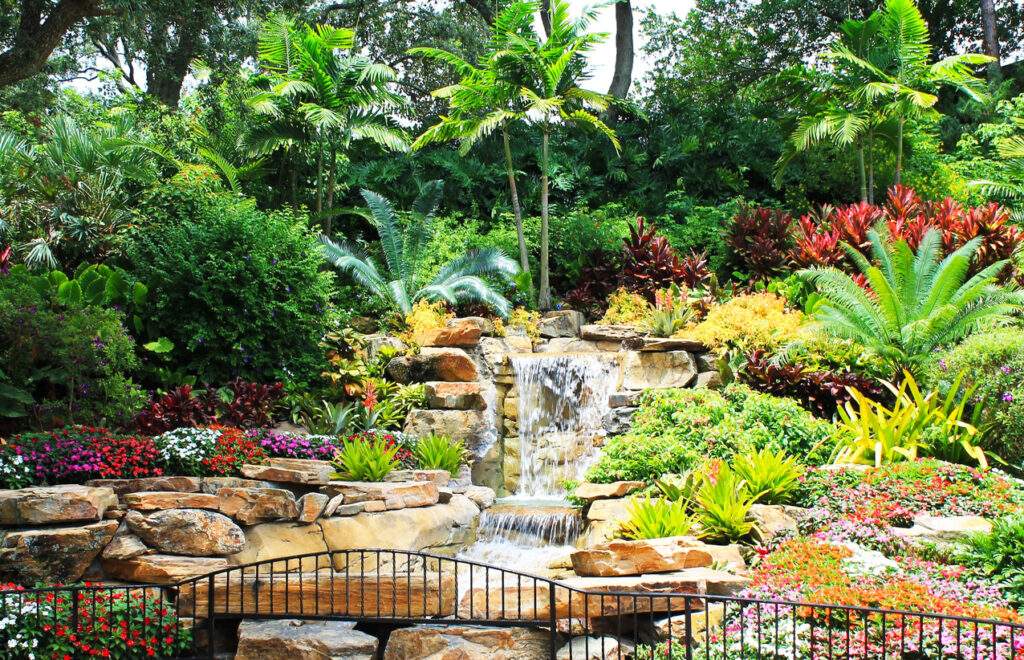
Intersect nature and architecture by installing a pond, fountain, pool, or bird bath. These water features are calming, and some are great for attracting birds.
4. Install a Fire Pit
A nice north or central Florida landscaping idea is to install a fire pit in the backyard for colder and milder winter nights. A fire can even be enjoyable in South Florida to keep mosquitos away.
Fire pits act as focal points for your yard and are perfect for seating areas to entertain guests.
Important Notes on Fire Pits
Be sure to install fire pits far enough away from your residence to avoid an accidental fire.
Also, though distance helps reduce your risk of an accidental fire, the wind can carry burning embers from the pit and set dry grass or foliage on fire. Ensure you have a cover on your fire pit or keep a watchful eye on the fire to reduce your risk of a fire.
5. Make Use of Pots
Functional and decorative pots add beauty, color, and texture to your yard. To define otherwise bare areas, you can use them with or without plants on patios, decks, and around your lawn.
You can also try raised plant beds to increase the area where you grow plants.
Using pots for plants makes them easier to water and tend to from your patio or deck—no more stretching your garden hose.
6. Choose Outdoor Furniture You’ll Love
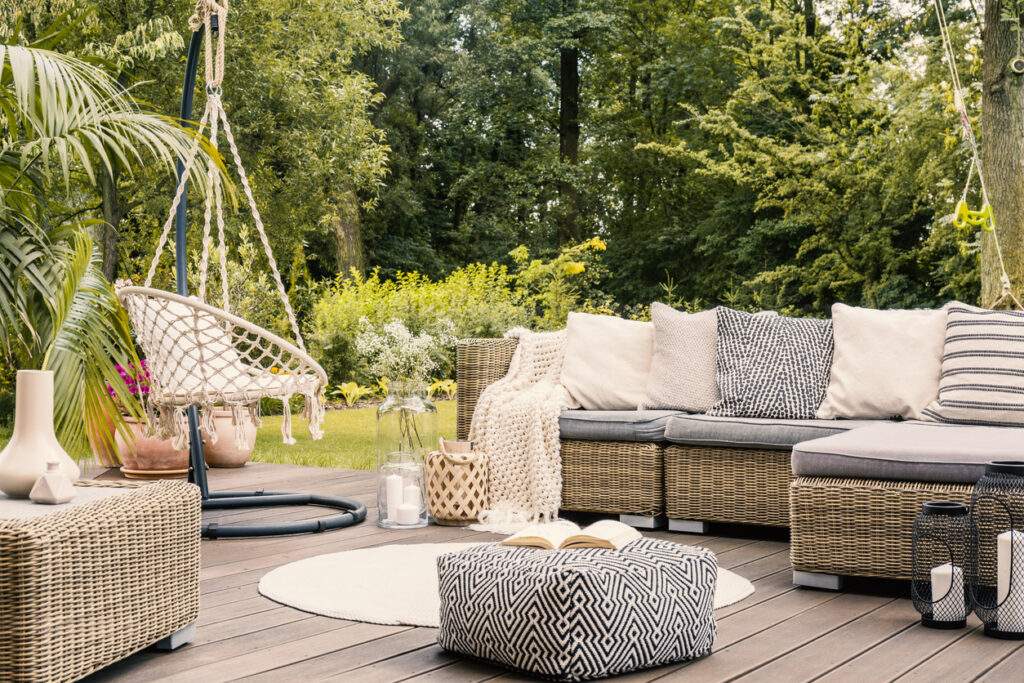
You’ll likely spend a lot of time outdoors, so your outdoor furniture set should create a comfortable and interesting theme that lasts a long time.
Experiment with colorful, textured, and durable furniture based on your yard and preferences.
7. Have Fun With Other Garden Ornaments
While water features and containers are also decorative, other garden ornaments like stone statues, trellises, and arches transform your yard with memorable designs. The only maintenance these ornaments require is an annual cleaning.
When choosing your ornaments, aim for larger items that fit with your overall Florida backyard design instead of several small, unrelated items throughout.
8. Create Several Seating Areas
Divide your yard into multiple small seating areas to add a variety of experiences to your yard. You can experiment with materials like brick, pavers, stone, and gravel that drain Florida’s frequent rain for a consistently comfortable experience.
Strategically creating more seating spaces for household members and guests helps to organize your yard into usable sections that fill up open space.
9. Separate Plants With Fencing, Walls, or Paths
Tidy up your yard between plant beds with low fencing, garden walls, or paved paths. These elements provide structure and easy access to plant beds when watering or tending to plants.
Separating your plant beds with these hardscaping elements also prevents soil erosion and root clutter.
10. Reuse or Repurpose Old Materials
You can use creativity to transform broken concrete or metal from past home projects into clever yard features, such as pots, paving, and decorations.
With some imagination, you can repurpose vintage items like old appliances or sections of a wrought-iron fence into charming garden decor.
The Scope of Your ‘Scape
Taking the time to explore these simple Florida landscaping ideas will pay off in the end. Not only will you have a wonderful space to enjoy the Florida sun, but you may also increase the value of your property.
And the more time you spend reviewing Florida landscaping ideas and tips, the more intentional your decisions will become.
When you make smart choices for your yard, you end up stepping outside your house each day, looking around, and saying, “Wow. I love what I did here.”
